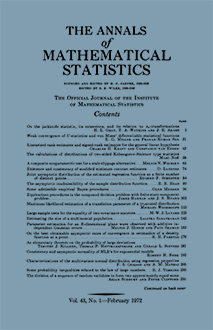Abstract
For testing a composite hypothesis, critical regions are determined which are most powerful against a particular alternative at a given level of significance. Here a region is said to have level of significance $\epsilon$ if the probability of the region under the hypothesis tested is bounded above by $\epsilon$. These problems have been considered by Neyman, Pearson and others, subject to the condition that the critical region be similar. In testing the hypothesis specifying the value of the variance of a normal distribution with unknown mean against an alternative with larger variance, and in some other problems, the best similar region is also most powerful in the sense of this paper. However, in the analogous problem when the variance under the alternative hypothesis is less than that under the hypothesis tested, in the case of Student's hypothesis when the level of significance is less than $\frac{1}{2}$, and in some other cases, the best similar region is not most powerful in the sense of this paper. There exist most powerful tests which are quite good against certain alternatives in some cases where no proper similar region exists. These results indicate that in some practical cases the standard test is not best if the class of alternatives is sufficiently restricted.
Citation
E. L. Lehmann. C. Stein. "Most Powerful Tests of Composite Hypotheses. I. Normal Distributions." Ann. Math. Statist. 19 (4) 495 - 516, December, 1948. https://doi.org/10.1214/aoms/1177730147
Information





